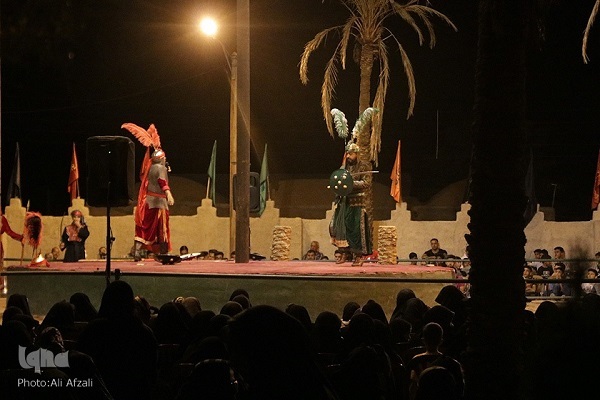Ta’ziyeh, A Play Recounting The Sorrowful Tragedy of Karbala

Ta’ziyeh is a passion play, a dramatic performance representing the bravery and sufferings of Imam Hussein (AS), the third Shia Imam, his offspring and valiant companions who fought the mercenary soldiers serving the illegitimate ruler of the time Yazid I.
Imam Hussein (AS), the grandson of Prophet Muhammad (PBUH), refrained from giving allegiance to Yazid, the second Umayyad caliphate as his appointment and hereditary succession to the throne was opposed and denounced by several grandees of the time including Imam Hussein (AS) himself.
In 680, Imam Hussain, staying in Mecca, received a series of letters from people of Kufa, a city in Iraq, urging him to lead them in their revolt against the tyrant caliphate Yazid.
Imam Hussein (AS) did not rush to take a decision. He sent his cousin Muslim bin Aqil, to Kufa as his emissary. He instructed Ibn Aqil to ascertain the truth of the Kufan allegiance and report back.
While the subsequent events made Ibn Aqil confident of Kufan support for Imam Hussein (AS), he sent a letter, assuring him of the extent of Kufan enthusiasm, so he decides to go to Iraq.
Nonetheless, Yazid who learnt about the insurrection in Kufa appointed the infamous Ubaidullah bin Ziyad, as the governor of Kufa, to replace the mild-tempered governor of the town, Noman bin Bashir.
Ibn Ziyad frightened the Kufan and declared harsh punishment and death for supporters of Imam Hussein (AS).
The disloyal Kufan, stricken by awe and fear, abandoned Ibn Aqil, who was later captured and beheaded by Ibn Ziyad’s agents.
On his way to Kufa, Imam Hussein (AS) learnt about Ibn Aqil’s death. However, he continued to march towards Kufa.
He was blocked by Ibn Ziyad’s army before entering the city and forced to camp in the desert of Karbala. Negotiations failed as Imam Hussein refused to swear an oath of allegiance to Yazid.
Ibn Ziyad’s army blocked Imam Hussein (AS) camp’s access to water three days before the war broke out between the two armies.
On Muharram 10, 61 (falling on October 10, 680), Imam Hussein (AS) and all his 72 loyal companions were savagely martyred while female members of his family were taken prisoners.
The betrayal of Kufan, the hardships Imam Hussein, his family and followers went through during the siege and the blockade of the Euphrates River water, have inspired various mourning rituals throughout history like Ta’ziyeh.
Origins
In the 16th century, the Safavid Dynasty declared Shiism as the official religion of Iran. Since then, Muharram observances assumed a central position in the cultural and religious identity of the country.
The golden age of Ta’ziyeh, literally meaning to mourn and console, was during Qajar dynasty (1789–1925).
During Pahlavi dynasty (1925-1979) the ritual was banned by the incumbent regime as it was associated with resistance to the authority. For many, the Pahlavi was identified with Yazid’s rule, a tyrant and corrupt one.
For Shia Muslims, the battle of Karbala is a symbol of sacrifice and a struggle for justice. It teaches them not to support oppression no matter how powerful the oppressor might be, and that is one of the main themes of Ta’ziyeh.
Today, Ta’ziyeh is performed across Iran as well as countries with Shia Muslim communities.
The dramatic performance, along with many other Muharram mourning rituals that survived throughout history, is used as a framework to revive the memory of Imam Hossein (AS) and his sacrifice to keep Islam alive, as well as a means to protest against the contemporary dictators.
By Maryam Qarehgolzou



